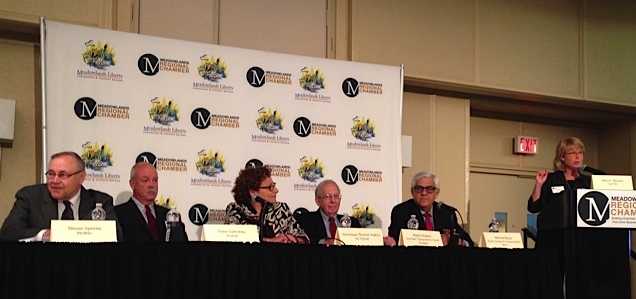1910 is the last time a rail connection was built across the Hudson River. Since then competition between the states and the emergence of the automobile resulted in no improvement in public transit connectivity. At a packed Symposium convened by the Meadowlands Chamber of Commerce last week, a panel of Transportation and Business Executives called for a future where to compete in the global markets and succeed, both states need to work together as a Region.
Steven Spinola, head of the powerful Real Estate Board of New York, opened his remarks as saying: “30 years ago I came to this state to debate how New York competes with New Jersey : I was wrong! we need to work together as a region” and Veronique Hakim, Executive Director, NJ Transit discussed her model of Cross Hudson partnerships to resolve problems on the ground on both sides of the river.
 John Robert Smith , CEO, Transportation4 America opened with statistics on generational and population changes that are already taking place and will accelerate in the near future. Less and less people want to use their cars in the US and especially in the region. 77% of americans want to live in a pedestrian friendly neighborhood . To attract highly qualified employees, corporations have to locate downtown or in proximity to transit. For municipalities, property taxes generated by a pedestrian friendly neighborhood are 100 X those generated by Walmart on a per foot basis. eh jobs per acre are 73. 7 instead of 5.9 per acre for Walmart. Proposed changes to the Federal funding may give more power to the regions to select the most critical regional projects that should be funded by Washington.
John Robert Smith , CEO, Transportation4 America opened with statistics on generational and population changes that are already taking place and will accelerate in the near future. Less and less people want to use their cars in the US and especially in the region. 77% of americans want to live in a pedestrian friendly neighborhood . To attract highly qualified employees, corporations have to locate downtown or in proximity to transit. For municipalities, property taxes generated by a pedestrian friendly neighborhood are 100 X those generated by Walmart on a per foot basis. eh jobs per acre are 73. 7 instead of 5.9 per acre for Walmart. Proposed changes to the Federal funding may give more power to the regions to select the most critical regional projects that should be funded by Washington.
Mitchell Moss, Director, Rudin Center for Transportation (NYU) illustrated how much New Jersey and New York are already functioning as a region, with many examples and – what else – a map of the “New York ” sports team some of them with a home in New Jersey , and the transit options to visit them . Powerful message. If we are all cheering for the same team, we are probably on the same team.
Martin Robins, Fellow at Rutgers University Transportation Center, pointed out the need for a joint prioritization of trans Hudson projects and the need of both a rail and subway crossing. Obviously Port Authority is more focused on maintaining existing facilitates on both sides of the river, and especially bridges as Michael Massiah, Chief, Capital Planning , Port Authority NY&NJ described .
Drew Galloway, Chief Planning and Performance, Amtrak described efforts to improve capacity across the river, by the expansion of the Amtrack platforms under Moynihan Station, the construction of Gateway, an enclosed easement under the Hudson Rail Yards, to preserve the opportunity to build a new rail tunnel, and other projects which taken together are the foundation for a future new Hudson Crossing by rail .
While Veronique Hakim described the magnitude of capacity and customer service problems faced by New Jersey Transit and announced short term changes that will eased the problem, Steve Spinola raised the challenge of the long term solution: “Extending the # 7 to New Jersy is too good an idea to let it languish because of lack of funding”. On a per passenger basis the costs would be less than the price of the La Guardia airport renovation and would yield a massive economic benefit in increasing the pool of workers, increasing property values, and quality of life for residents and commuters. In a recent survey 85% of business respondents in New Jersey.com voted in favor of expanding the #7 line from 33rd Street and 11th Avenue to Secaucus., where a new bus terminal would be built and thus remove the need for many buses to bring commuters to the West side. They would board the subway in Secaucus. see more on the proposal here
Rutgers university is undertaking a study to qualify the economic benefits of such a connection. See article
